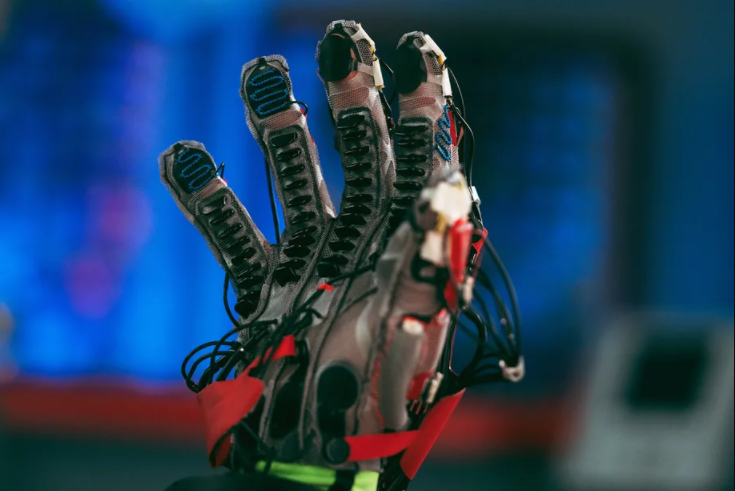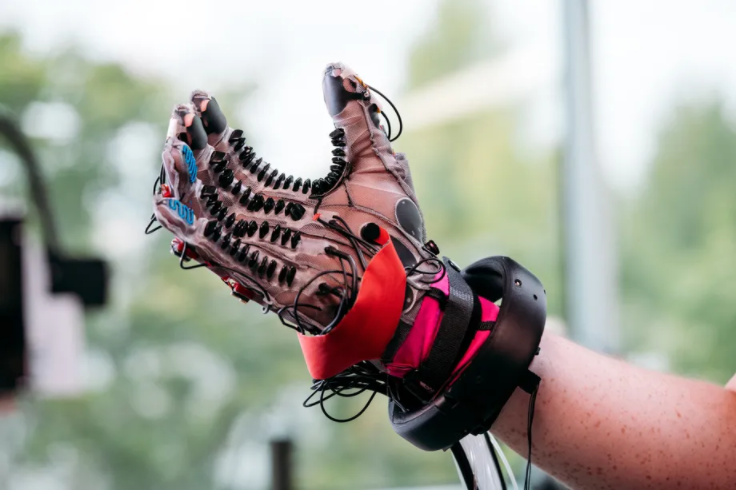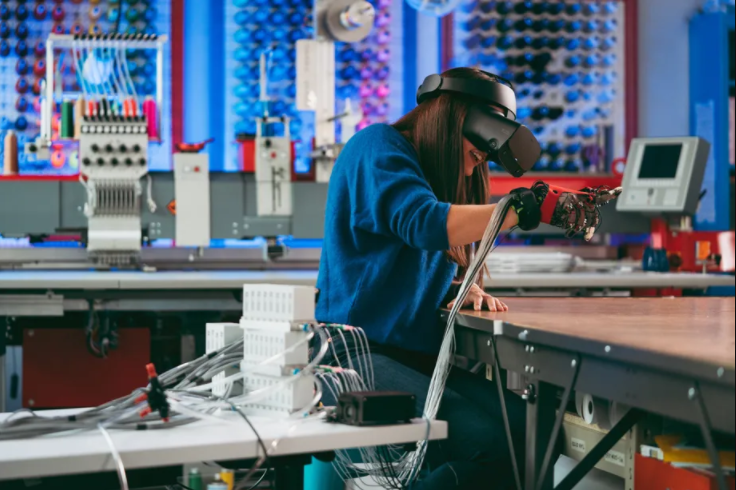New Meta Haptic Gloves Let You Feel Virtual Objects via Air Pockets
Meta, formerly Facebook, will be spending $10 billion on AR/VR and metaverse hardware in 2021. One of its projects is the haptic gloves prototype that leverages inflatable pads to simulate the sense of touch in virtual reality.
Haptic technology hasn’t reached a level of refinement that would allow us to get a convincing touch sensation in virtual reality. Several haptic innovations by disparate players are gradually taking us in that direction. The latest one is Meta’s haptic glove prototype.

Meta is currently making several bold moves towards the realization of metaverse. As a result, the company is throwing lots of investments into the platforms and hardware that would make this a reality.
Meta has been working on a haptic glove for the past 7 years, its most ambitious haptic project yet., The project entails developing a haptic glove capable of reproducing sensations such as grasping an object or running your hand along a surface inside an immersive environment. The glove isn’t coming out of the Reality Labs research division yet (or at all) but the company has for the first time showcased a prototype of the device. The company sees this device along with other VR and AR hardware as the future of the metaverse, particularly when it comes to AR and VR interactions.
The Meta haptics glove is lined with approximately fifteen ridged and inflatable plastic pads that serve as actuators. These pads have been arranged to fit along the palm of the glove wearer, the underside of the wearer’s fingers as well as their fingertips. These haptic gloves act as virtual reality controllers with the back part featuring small white markers that allow cameras to track the movement of fingers through space. The Meta haptic gloves also have internal sensors which capture how the wearer’s fingers bend.

When a user wears the haptic glove and immerses themselves in a VR or AR experience, the level of inflation in the glove is adjusted by a sophisticated control system that generates pressure on different parts of the wearer’s hands. When the wearer touches a virtual object using their fingertips, they will feel the sensation of the virtual object pressing against their skin. When a user grips a virtual object, the long finger actuators in the haptic glove stiffen to generate a sensation of resistance. These haptic sensations work in concert with the visual and audio cues to create an illusion of physical touch.
The technology used in these haptic gloves leverages the emerging field of soft robotics where the bulkier motors used in conventional robotics are replaced with tiny air valves. This is technology has been long coming and Meta has been developing it over the past 7 years, right from the moment the company acquired Oculus VR in 2014. The first prototype was developed in 2015 and consisted of a single finger with one actuator.
There are various other haptic innovations that attempt to simulate touch. Even rudimentary haptic technology that merges virtual reality with simple controller vibrations can provide for convincing haptic sensations giving users the illusion that they are actually touching something in virtual reality. Several companies working in this field have come up with haptic wearables capable of tracking a user’s hands or create a haptic sensation. There are some haptic solutions that go as far as simulating temperature sensations. Meta’s Reality Labs isn’t prioritizing temperature sensations at the moment.
With its extensive research in haptics technology, Meta seems poised for the launch of a mass-market haptic glove like no other company has done so far. At the moment, the majority of the haptic products are specialized products for use in specific enterprise segments such as the military, academic institutions, or industrial applications.
Meta, in contrast, has a consumer focus. Its Quest VR ecosystem is consumer-oriented. The company has also invested billions of dollars into building a metaverse that will integrate both virtual reality and augmented reality.
Should Meta roll out these haptic gloves in the coming years, they will certainly be compatible with the Quest system and developers will be encouraged to utilize it.
Reality Labs is visualizing haptic gloves being used as one of the many controller methods for future headsets and glasses and would be used alongside other lightweight solutions that have been developed around electromyography or EMG which refers to a system capable of reading nerve signals on the arms and then translating these into digital input. In 2019, Meta acquired CTRL-Labs, an EMG wristband company. The EMG team at Meta is working separately from its haptics design team but there could be possible overlaps in the future between these two technologies.
Still, barriers exist that stand in the way of consumer-friendly haptic gloves. The Meta team wants a drastic increase in the glove actuator density and take it from a few dozen to hundreds in just a few years.
At the moment, Meta’s haptic gloves can give users a sense of the object’s contours. However, they still don’t have fine distinctions between surfaces and they leverage the “suggestive power of audio and images” according to The Verge. To get the real sensation of petting a virtual dog, for instance, the gloves will need a high-density actuation that will really capture the sensation at a granular level. While Meta will not be targeting a sensation as specific as a fur, it wants to produce haptic gloves capable of broadly simulating high-quality sensations.

The other major challenge with Meta’s haptic gloves is that of miniaturization. The size of the gloves needs to be reduced considerably. The current Meta prototype is still a lot bulkier. Meta wants the device to be light enough to enable people to use them comfortably to interact with both the real and the virtual world. The gloves will also need to be fully wireless. The current prototype still relies on a tether.
Further complicating practical implementations is the fact that a haptic glove must precisely fit against the skin of the wearer. Meta could possibly design haptic gloves that fit differently for every buyer. This could be realizable with processes such as 3D knitting that can be used to create a clothing object from custom-sized digital designs.
As gloves are used repeatedly and probably by different people, they will also need to be cleaned on a regular basis. This can pose a challenge when you are dealing with a delicate high-tech haptic glove. Meta’s prototype is cleaned by wiping down with alcohol. If the haptic gloves will be made from garments, then they will need to be washable. Meta says it wants to create haptic gloves that could be washable although it still has no idea on how this could be actualized.
Finally, if the haptic gloves will be commercialized, they will still have to reckon with the security and privacy concerns that other wearables that gather biometric information grapple with. Wearable technologies can usually analyze a user physical motion at a very granular level. Even typing patterns can be used to predict the onsets of diseases such as Parkinson’s. Meta will therefore need to institute privacy and security policies that will govern the amount of data that will be left on a wearer’s device and the kind of people who will have access to such data.
For the time being, the team is focused on the fundamentals: realizing a realistic VR touch sensation. Still, Meta concedes that haptic sensations might not reproduce an exact realistic touch sensation in the same way that sounds and images can be reproduced with exactness. A haptic glove, for instance, will not stop your hands from going through a virtual table.
https://virtualrealitytimes.com/2021/11/19/new-meta-haptic-gloves-let-you-feel-virtual-objects-via-air-pockets/https://virtualrealitytimes.com/wp-content/uploads/2021/11/Meta-Haptic-Glove-Prototype-600x399.pnghttps://virtualrealitytimes.com/wp-content/uploads/2021/11/Meta-Haptic-Glove-Prototype-150x90.pngHapticsHardwareTechnologyMeta, formerly Facebook, will be spending $10 billion on AR/VR and metaverse hardware in 2021. One of its projects is the haptic gloves prototype that leverages inflatable pads to simulate the sense of touch in virtual reality. Haptic technology hasn’t reached a level of refinement that would allow us to...Sam OchanjiSam Ochanji[email protected]EditorVirtual Reality Times - Metaverse & VR
